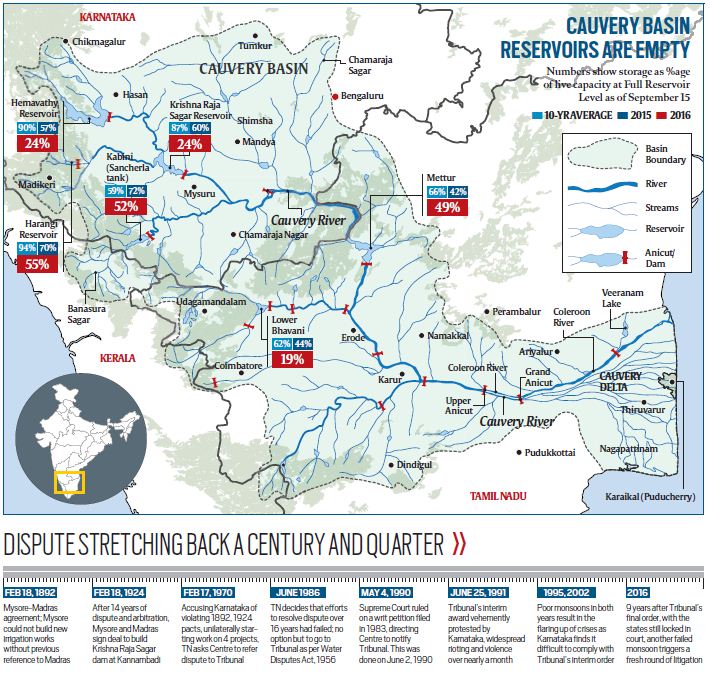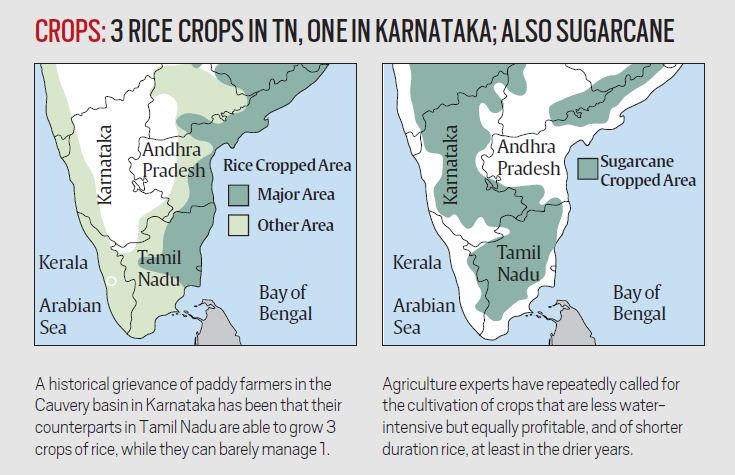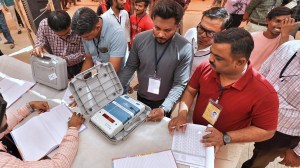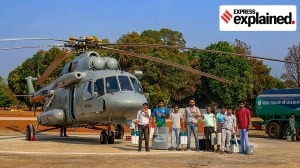- India
- International
Cauvery water dispute: The jewel among maidens, the life force of civilisation
For centuries, the Cauvery has fostered civilisations, kingdoms have risen on her banks, and her bounty has allowed rulers to build great temples and empires stretching beyond the seas.
 The Supreme Court had earlier on September 5 asked the Karnataka Government to release 15,000 cusecs of Cauvery water to Tamil Nadu on a daily basis for the following 10 days. (File)
The Supreme Court had earlier on September 5 asked the Karnataka Government to release 15,000 cusecs of Cauvery water to Tamil Nadu on a daily basis for the following 10 days. (File)
Long, long ago, when time was a river, there lived a rishi called Kavera.
He had a daughter named Lopamudra. She was married to the sage Agastya, who kept her in his kamandalu. Once when a famine stalked the land, Lord Brahma took the form of a crow and tipped the kamandalu. And out fell Kavera’s daughter — Kaveri — who took the form of a river to bring relief and prosperity. The Skanda Purana and Agni Purana tell the story a little
differently. In some tellings, Kavera is a king; and Lopamudra, a representation of Vishnu’s maya, has twin manifestations of a human and holy water. In all of them, Kaveri, or Cauvery, assumes the state of a river goddess with immense capacity to love and nurture. Not surprisingly, she is counted among the seven sacred rivers invoked in the nitya vandana sloka, Gange cha Yamune chaiva Godavari Saraswati/ Narmada Sindhu Kaveri jalesmin sannidham kuru.
And did she not for centuries? She fostered civilisations, kingdoms rose on her banks, her bounty allowed rulers to build great temples and empires that stretched beyond the seas. The Tamil epics, Silappadikaram and Manimekalai, celebrated her beauty, the hymns of the Azhvars and Nayanmars (Vaisnavite and Saivaite saints) sanctified her sacredness. In the music of
the great Carnatic composers, and the scholars and writers who lived and wrote in the towns and villages that flourished in the river’s fertile delta, the Cauvery emerged as the vital force of Tamil civilisation.
Contemporary history offers little scope for mythology. In present times, the Cauvery has been reduced to a utility measurable in cusecs and TMC feet, a jug of statistics, selectively deployed by its consumers. It is a river that now divides people, because people have chosen to forget that the Cauvery is one river, which needs care as it flows from the Brahmagiri hills in Coorg, past the Mysuru plateau and the ghats on the Tamil Nadu border to form the Akhanda Cauvery before splitting into numerous channels that empty into the Bay of Bengal. Dammed extensively, polluted with abandon, mined heavily for sand — in Karnataka and Tamil Nadu, the Cauvery is a pale shadow of its glorious past.

Despite the deprivations heaped on it by the industrial age, the Cauvery still has much to offer to the discerning pilgrim. The sacred geography of the river begins at Talacauvery in Coorg, as a mountain stream. Temples testify to its holiness as the river journeys past Somanathapura, Bhagamandala, Srirangapatna and Sivasamudram in Karnataka to enter Tamil Nadu. Though there is no Cauvery parikrama like the Narmada, two renowned Tamil writers, Thi Janakiraman and Chitti, undertook one in the 1960s, and wrote their experiences. Nadanthai Vazhi Kaveri (‘Eternal Kaveri’ in English translation) is a remarkable cultural history of the river and its cultural heritage.

As the myth suggests, the Cauvery represents relief and prosperity to people who live off its resources. When the river turns dry, famine stalks its basin, in Karnataka and Tamil Nadu. The Tamil kingdoms that rose in the Cauvery basin were early puveyors of irrigation projects. The oldest dam on the river, Kallanai, upstream of the city of Trichy, is said to have been
built by Karikala Chola, who ruled Cholamandalam in the 2nd century. The great Cholas who followed in the 9th century, Rajaraja and Rajendra, expanded on the irrigation works to spread the Cauvery to a large area and generate agricultural surplus that enabled them to build an empire. The great temples of Chidambaram, Thanjavur, Srirangam, Darasuram,
Gangaikondacholapuram, Kumbakonam, Thiruvarur — the list is endless –came up along the many distributaries of the river. At the great Chola port city of Kaveripoompattanam or Poompuhar, trading ships from distant lands docked. The port, described in great detail in Silappadikaram, has now been lost to the sea, and the river can be crossed on foot in the lean season.
The delta is a mosaic of diverse faiths. The great basilica at Velankanni, the churches of Trichy, an early centre of Christianity in the Tamil region, the Sufi centre of Nagore, are major centres of pilgrimage. Out of Chidambaram’s spiritual universe grew the iconography of the Nataraja.
 Sources: Reservoir storage data from Central Water Commission Weekly Report on 91 Important Reservoirsfor week ending September 15, 2016 (latest available); map details and related information from Report of the Cauvery River Water Disputes Tribunal; Rainfall, irrigation and crop patterns data from India Meteorological Department and Statistical Yearbook, India. Graphic: Subrata Dhar
Sources: Reservoir storage data from Central Water Commission Weekly Report on 91 Important Reservoirsfor week ending September 15, 2016 (latest available); map details and related information from Report of the Cauvery River Water Disputes Tribunal; Rainfall, irrigation and crop patterns data from India Meteorological Department and Statistical Yearbook, India. Graphic: Subrata Dhar
Music became synonymous with the river. The trinity of Carnatic music, Thyagaraja Swamikal, Muthuswami Dikshitar and Shyama Sastri, were born in Thiruvarur in the Cauvery delta.
Thyagaraja, a mendicant, stayed close to the river all his life. He lived and died at Thiruvaiyyaru, a quiet village on the banks of the Cauvery. His composition in Asaveri raga, Saari vedalina ee Kaverini joodare, is a celebration of the river — Vara Kaveri kanyakaamani, or ‘This jewel among maidens’, he calls the river. It was in the Thanjavur court that the western violin became an accompanying instrument for Carnatic recitals.
Craftsmanship in the form of textiles, bronze casting and brass work, and veena manufacturing flourished.
With the rise of Madras as the city of the Empire, the cities on the Cauvery began to lose their preeminence as centres of culture. But the river itself flowed quietly, inspiring poets not just in Tamil, but even in other tongues.
The story of the Cauvery today is the story of an over-exploited river and its overdeveloped basin. Karnataka was a late entrant to the race to channelise the Cauvery’s waters. As the upper riparian state began to insist on its share of water last century, the delta downstream started to complain. The excessive dependence on dam-centric irrigation had already led to the neglect of ponds and eris (tanks) that had nourished the delta.
 Sources: Reservoir storage data from Central Water Commission Weekly Report on 91 Important Reservoirsfor week ending September 15, 2016 (latest available); map details and related information from Report of the Cauvery River Water Disputes Tribunal; Rainfall, irrigation and crop patterns data from India Meteorological Department and Statistical Yearbook, India. Graphic: Subrata Dhar
Sources: Reservoir storage data from Central Water Commission Weekly Report on 91 Important Reservoirsfor week ending September 15, 2016 (latest available); map details and related information from Report of the Cauvery River Water Disputes Tribunal; Rainfall, irrigation and crop patterns data from India Meteorological Department and Statistical Yearbook, India. Graphic: Subrata Dhar
The impact of industrialisation and urbanisation along the river had an even more devastating impact. Tributaries like the Noyyal that flows past the textile city of Tirupur are now toxic streams. Farmers along the Noyyal have nothing left on their farms, with seepage from the river ruining even wells. At Noyyal village, where it joins the Cauvery, the water stinks and
dead fish mark the sand banks of the great river.
Ilango Adigal describes her in the Silappadikaram thus: “Neither angry Saturn, nor the comets wandering in the sky, nor brilliant Venus whose descent to the southern stars is a sign of drought, can perturb the river Kaveri, born of a thunderbolt in the wind-swept rain-blessed mountains of Coorg. Spreading prosperity wherever she passes, she runs towards the swelling tide that brings into her bed the treasures of the sea.”
But the eternal Kaveri that Ilango Adigal describes may disappear into the Earth if the blind rush to suck out every drop of its water for industry and irrigation continues. The curse of the goddess can turn the land barren.
More Explained
EXPRESS OPINION
Apr 18: Latest News
- 01
- 02
- 03
- 04
- 05








































